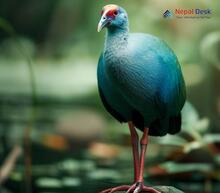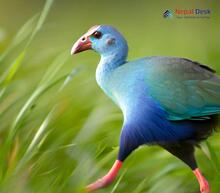The Porphyrio genus, a group of colorful, medium-sized birds commonly known as swamphens or purple gallinules, has piqued the interest of bird enthusiasts and scientists alike. From their origin and evolutionary history to their taxonomy and morphology, these fascinating creatures hold secrets waiting to be explored. Intriguingly, the Porphyrio genus also has a presence in Nepal. Let us unravel the mysteries surrounding these exceptional birds:
Origin and Evolutionary History
The Porphyrio genus is part of the Rallidae family, which consists of several bird species thriving in wetlands across various continents. The earliest known ancestors of the Porphyrio genus are believed to have existed over 20 million years ago. Fossil evidence has been found in Europe and across other parts of the world, suggesting that these ancient birds once had a much wider distribution than today.
Taxonomy
Taxonomists divide the Porphyrio genus into several distinct species based on physical characteristics and geographical distribution. Despite ongoing research and study, it remains challenging due to the striking similarities and hybridization between different species. Currently, there are around six recognized species within the Porphyrio genus: P. porphyrio, P. martinicus, P. poliocephalus, P. albus, P. mantelli, and P. hochstetteri.
Morphology
Porphyrio birds are known for their vivid coloration and slightly bulky appearance. They exhibit a striking mix of purple-blue plumage on their head, neck, and breast areas while boasting green-blue hues on their wings and tail feathers. Adults have red beaks with yellow tips and bright red or orange legs during the breeding season, giving them quite a captivating appearance.
Ecology
Swamphens prefer wetland habitats such as marshes, ponds, swamps, and even rice paddies where they can find an abundance of food resources. Their diet mainly consists of aquatic plants, insects, small invertebrates, and an occasional small vertebrate. Porphyrio birds have a hinged lower mandible, enabling them to snip off plant parts and feed on a wide range of vegetation.
Presence in Nepal
In Nepal, the Porphyrio poliocephalus, also known as the grey-headed swamphen, stands out as the most prominent species from the genus. Their presence expands across southern parts of the nation accompanied by wetland ecosystems such as Koshi Tappu Wildlife Reserve and Chitwan National Park where they can be observed in their natural habitat. The grey-headed swamphen is considered as a resident bird in this region, contributing to Nepal's rich biodiversity.
In summary, the Porphyrio genus holds great interest for researchers and bird enthusiasts alike due to its captivating appearance, intriguing evolutionary history, and diverse presence globally. A substantial presence in Nepal further emphasizes the importance of conserving these remarkable avian wonders and their habitats for future generations to study and appreciate.




